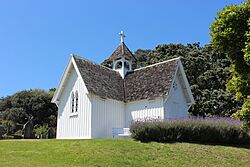St Stephen's Chapel, Auckland facts for kids
Quick facts for kids St Stephen's Chapel |
|
|---|---|

St Stephen's Chapel in 2018
|
|
| Denomination | Anglican |
| History | |
| Status | Chapel and churchyard |
| Dedication | Saint Stephen |
| Events | 1857 signing of the Constitution of the United Church of England and Ireland in New Zealand |
| Architecture | |
| Functional status | Active |
| Architect(s) | Frederick Thatcher |
| Style | Neo-Gothic |
| Completed | 1857 |
| Administration | |
| Parish | Cathedral of the Holy Trinity |
| Diocese | Auckland |
The St Stephen's Chapel is a very old and special Anglican chapel located in Parnell, Auckland, New Zealand. It's known for its unique design and important history. This chapel and its surrounding churchyard (a burial ground) are considered a Category 1 historic place by Heritage New Zealand. This means it's a really important building that needs to be protected.
Contents
What Does St Stephen's Chapel Look Like?
St Stephen's Chapel sits high up, overlooking Judge's Bay. It has a special design called Neo-Gothic, which means it looks like old European churches.
Unique Shape and Features
Unlike most churches that are shaped like a Latin cross (a long cross), St Stephen's Chapel is built in the shape of a Greek cross. This means all four arms of the cross are the same length. The chapel is made up of five square sections, each about 10 feet by 10 feet. It has tall, pointed roofs and narrow, tall windows called lancet windows. In the middle of the roof, there's a small tower called a belfry, where a bell would usually hang.
A Look Back in Time: History
The story of St Stephen's Chapel begins with George Augustus Selwyn, who was the first Bishop of New Zealand. He moved to Parnell in 1844. At that time, the closest Anglican church was quite a distance away.
The First Chapel
Bishop Selwyn bought some land above Judge's Bay. He then paid for a chapel to be built, which he named St Stephen's Chapel. This first chapel was designed in an English Gothic style. It was built using scoria (a type of volcanic rock) and rubble (broken stones). However, the building wasn't very strong. In 1847, a big storm caused the chapel to fall down.
A New Beginning: The 1857 Chapel
In 1857, Bishop Selwyn decided to build a new chapel. This time, Frederick Thatcher was the architect. This new chapel is very special because it was likely built specifically for an important event. On June 13, 1857, the constitution for the United Church of England and Ireland in New Zealand was signed right there.
The chapel's Greek cross shape was chosen on purpose. It was a symbol for the new church being established. All other churches built for Bishop Selwyn used the more common Latin cross shape.
Restoring the Chapel
Over time, the chapel started to show its age and needed repairs. In the late 1920s, Archbishop Alfred Averill led efforts to restore it. Thanks to these efforts, the chapel was brought back to its good condition.
On September 1, 1983, the chapel and its churchyard were officially recognized as a Category I historic place by the New Zealand Historic Places Trust. This means it's one of the most important historic sites in the country.
Who is Buried Here?
The churchyard around St Stephen's Chapel is a burial ground. Many important people from New Zealand's history are buried there. Here are a few of them:
- Charles Baker (1803–1875), a missionary who helped spread Christianity.
- William Cowie (1831–1902), who became a bishop in the Anglican Diocese of Auckland.
- Josiah Firth (1826–1897), a well-known businessman and politician.
- James Kemp (1797–1872), another important missionary.
- Frederick Whitaker (1812–1891), who served as the premier of New Zealand (like a prime minister) two times.
- Reader Wood (1821–1895), a politician and also an architect.
Images for kids
External links


